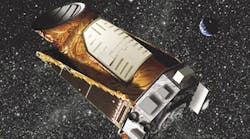NASA says two of the Kepler space telescope’s four gyroscopic reaction wheels have failed, making it inoperable for its mission — imaging planets in other solar systems. The reaction wheels let Kepler precisely hold position, which is critical for the long exposures the satellite’s optics need to gather clear images from outside our solar system.
One reaction wheel failed last year, but it was a redundant assembly, and the satellite could function using three wheels. But then a second wheel failed in May, a problem not entirely unexpected, according to NASA administrator John Grunsfeld. “We have some history with wheels by this manufacturer, that they have a limited lifetime,” he explains.
After the second failure, NASA engineers started using onboard thrusters to keep Kepler in the right position and orientated so the solar panels faced the Sun. When they then tried to give control back to the reaction wheels and halt the spinning telescope, three wheels responded properly. But the fourth remained at full torque, a clear sign the wheel has an internal failure. Engineers switched back to thruster control, confident there will be enough fuel to last several months. And if NASA puts the spacecraft in “rest” mode, it could remain on station for several years while engineers decide what to do with it.
Fortunately, Kepler has completed its planned 3.5‑year mission since being launched in March of 2009. It has already found 2,165 eclipsing binary stars, 2,740 possible planets, and 132 definite planets. Many of these newly found planets appear to be Earth-sized and within their star’s habitable zone, where water could exist in liquid form. Plus, there is still a year-and-a-half-worth of data still in the pipeline that scientists have yet to examine. So Kepler will likely be responsible for future planetary discoveries despite being out of action.
Resources: NASA, More on NASA’s Kepler

